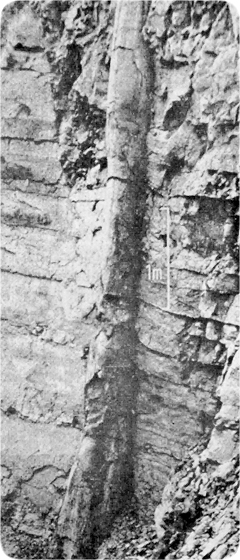Below is the online edition of In the Beginning: Compelling Evidence for Creation and the Flood,
by Dr. Walt Brown. Copyright © Center for Scientific Creation. All rights reserved.
Click here to order the hardbound 8th edition (2008) and other materials.
22. Parallel Strata
Earth’s sedimentary layers are typically parallel to adjacent layers. Such uniform layers are seen, for example, in the Grand Canyon and in road cuts in mountainous terrain. Had these parallel layers been deposited slowly over thousands of years, erosion would have cut many channels in the topmost layers. Their later burial by other sediments would produce nonparallel patterns. Because parallel layers are the general rule, and Earth’s surface erodes rapidly, one can conclude that almost all sedimentary layers were deposited rapidly relative to the local erosion rate—not over long periods of time. (The mechanism involved is explained on pages 197–213.)

Figure 11: Polystrate Fossil. Fossils crossing two or more sedimentary layers (strata) are called poly (many)-strate (strata) fossils. Consider how quickly this tree trunk in Germany must have been buried. Had burial been slow, the tree top would have decayed. Obviously, the tree could not have grown up through the strata without sunlight and air. The only alternative is rapid burial. Some polystrate trees are upside down, which could occur in a large flood. Soon after Mount St. Helens erupted in 1980, scientists saw trees being buried in a similar way in the lake-bottom sediments of Spirit Lake. Polystrate tree trunks are found worldwide. (Notice the 1-meter-scale bar, equal to 3.28 feet, in the center of the picture.)